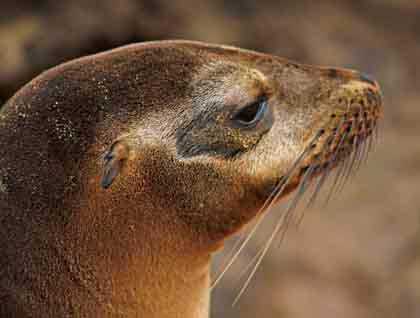In the Galápagos brochures, post cards, documentaries and books, Bartolomé is the most representative place of these islands. It is a very small island but nevertheless, this place has plenty of volcanic formations and unique animals such as the Galápagos penguins, the third smallest one in the world and found only in this remote archipelago. With its cindery slopes, spatter cones and lava fields scattered everywhere, this island looks like mars, or as we say, a “moonscape.”
A wooden trail with about 345 steps has been built all the way to the summit of Bartolomé, in order to preserve the fragile natural structures. Most part of the island is tuff, which is a compacted ash cemented as sandstone. The local population of endemic lava lizards has happily adopted this human infrastructure, as many of them use it as a sunbathing spot, making the most of the early morning sunshine. They were very fun to observe! Bartolomé Island, being in the path of the winds, has very little vegetation cover so the number of species here is very restricted due to the constant shortage of food. At the end of the hike we were amazed by the surrounding landscapes of Bartolomé Island and its famous Pinnacle Rock and the coast. Simply breathtaking! Upon returning on board the National Geographic Islander we enjoyed a delicious breakfast and then had the chance to return to Bartolomé, but this time to swim and snorkel. From the Zodiacs we could see that some sea turtles had been to the beach during the night, which was evident because of the various tracks left on the sand. This little bay is the home of a small colony of Galápagos penguins, of which we saw several around. The snorkeling is even better around the base of the Pinnacle Rock, and many of us could spot there some white-tipped reef sharks, parrot fishes, sea stars and more.
In the afternoon and after navigating for a couple of hours, we dropped anchor at Rabida. The scenery here looks so different! The lavas and the sand are reddish here, but in general the island looks emerald green since we are in the end of the Galápagos rainy season. Since the air and sea temperatures are just perfect, this was a great chance to enjoy the ocean once again. So, some of our guests decided to explore the Rabida coastline at their own pace on kayaks, while others preferred to snorkel again. Having seen sea turtles, feeding marine iguanas, King Angel fishes and Galápagos sea lions in the water, we can say that the snorkeling was successful. After exploring the underwater world, it was time to set foot ashore. We followed the trail that took us around a small corner of the island. The area is dominated by endemic prickly pears, incense trees and yellow cordia trees… everything was leafy or in bloom. The land birds, like the Darwin finches, Galápagos doves and mockingbirds, could not be happier, given the surplus of food available. As the day died out, we had to return to our landing beach where the Zodiacs waited for us, but we couldn’t leave without enjoying the last rays of the sun that quickly hides beyond the horizon, the reddish sunset lighted our ship anchored near the shores of Rabida. Great ending for a great day!







